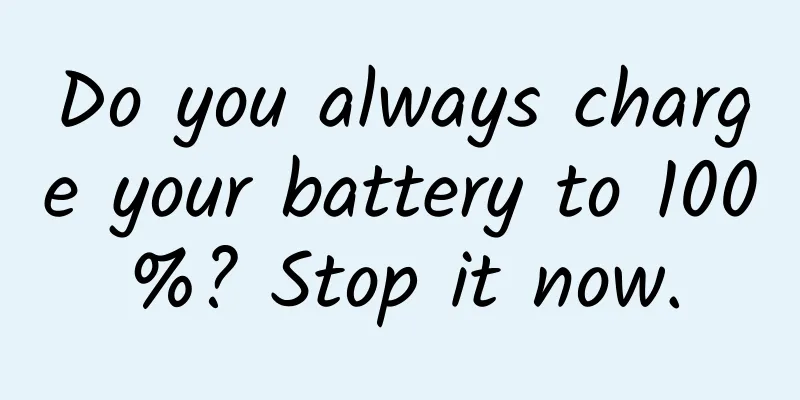Do you always charge your battery to 100%? Stop it now.

|
In today's life, mobile phones are not only a communication tool, but also play an increasingly important role in work, leisure and social interaction. In the process of using mobile phones, the most worrying thing is the low battery reminder of the mobile phone. LG conducted a survey in 2016, and the results showed that 90% of people feel "panic" when their mobile phone battery is less than 20%. Although major manufacturers are working hard to expand the capacity of mobile phone batteries, as the frequency and intensity of mobile phone use in daily life continue to rise, most people have gradually changed from charging once a day to charging multiple times a day, and many people even bring power banks with them when they go out in case of emergency. So, when we use our mobile phones in daily life, what can we do to extend the life of the mobile phone battery as much as possible? 01 How Lithium-ion Batteries Work At present, the batteries used in most mobile phones on the market are Nobel Prize-level achievements - lithium-ion batteries. Compared with traditional batteries such as nickel-metal hydride, zinc-manganese, and lead-acid batteries, lithium-ion batteries have the advantages of large capacity, small size, high voltage platform, and long cycle life. It is precisely because of these advantages that mobile phones can achieve a smaller appearance and longer battery life. The positive electrode of lithium-ion batteries in mobile phones usually uses LiCoO2 (lithium cobalt oxide), NCM, and NCA materials; the negative electrode materials in mobile phones mainly include artificial graphite, natural graphite, MCMB, SiO, etc. During the charging process, lithium is deintercalated from the positive electrode in the form of lithium ions, moves through the electrolyte and finally embeds into the negative electrode, while the discharge process is just the opposite. Therefore, the charging and discharging process is a cycle of lithium ions constantly embedding/deintercalating and inserting/deintercalating between the positive and negative electrodes, which is figuratively called a "rocking chair battery." Working principle of lithium battery: lithium ions continuously move back and forth between the positive and negative electrodes during charging and discharging. | Photo provided by the author 02 Reasons for the decline in lithium-ion battery life The battery life of a newly purchased mobile phone is quite good at first, but it will become less and less durable after using it for a period of time. For example, a new mobile phone can be used for about 36 to 48 hours after being fully charged, but after more than half a year, the same full charge may only last for 24 hours or even shorter. What exactly causes the "shortening" of mobile phone batteries? The main reasons are as follows: ① Overcharge and over discharge Lithium-ion batteries rely on the movement of lithium ions between the positive and negative electrodes to work. Therefore, the number of lithium ions that the positive and negative electrodes of lithium-ion batteries can accommodate is directly related to their capacity. When lithium-ion batteries are deeply charged and discharged, the structure of the positive and negative electrode materials may be damaged, and the space that can accommodate lithium ions becomes less, and then its capacity is reduced, which is what we often call a reduction in battery life. Electron microscope images of LiCoO2 cathode material before (a) and after (b) 50 cycles of deep charge and discharge Figure 2. LiCoO2 shows structural damage after deep charge and discharge Battery life is usually evaluated by cycle life, which is the number of charge and discharge cycles during which a lithium-ion battery can be deeply charged and discharged and its capacity can be maintained at more than 80%. The national standard GB/T18287 requires the cycle life of lithium-ion batteries in mobile phones to be no less than 300 times. Does this mean that our mobile phone batteries will become less durable after 300 charge and discharge cycles? The answer is no. First, in the measurement of cycle life, the attenuation of battery capacity is a gradual process, not a cliff-like or step-like process; second, lithium-ion batteries are deeply charged and discharged, and in daily use, the battery management system has a battery protection mechanism. It will automatically cut off the power after being fully charged and automatically shut down when the battery is low, which can avoid deep charging and discharging as much as possible. Therefore, the actual life of mobile phone batteries is more than 300 times. But we cannot completely rely on an excellent battery management system. Leaving the phone at low or full power for a long time may damage the battery and reduce its capacity. Therefore, the best way to charge the phone is to charge it shallowly and discharge it shallowly. When the phone is out of power, unplug it when it is full. When the phone is not used for a long time, keeping it half charged can also effectively extend its service life. Tuchong Creative ② Charging under overcold or overheated conditions Lithium-ion batteries also have high requirements for temperature. Their normal operating (discharging) temperature range is between 0°C and 35°C. Under low temperature conditions, the electrolyte ion conductivity decreases, the charge transfer impedance increases, and the performance of lithium-ion batteries will deteriorate. The intuitive feeling is the reduction in capacity. However, this capacity decay is reversible. After the temperature returns to room temperature, the performance of lithium-ion batteries will return to normal. However, if the battery is charged under low temperature conditions, the polarization of the negative electrode may cause its potential to reach the reduction potential of metallic lithium, which will lead to the deposition of lithium metal on the surface of the negative electrode. On the one hand, this will lead to a reduction in battery capacity, and on the other hand, there is the possibility of lithium dendrites forming, causing battery short circuit and thus causing danger. Charging a lithium-ion battery under high temperature conditions will also change the structure of the positive and negative electrodes of the lithium ions, leading to irreversible attenuation of the battery capacity. Therefore, avoiding charging your phone in overcold or overheated conditions can also effectively extend its service life. Tuchong Creative 03 Are these claims about charging reasonable? ① Will charging overnight affect the battery life of my mobile phone? Overcharging and over-discharging will affect the life of the battery, but charging overnight does not mean overcharging. On the one hand, the phone will automatically cut off power after being fully charged; on the other hand, many mobile phones currently use a charging method that first fast charges the battery to 80% capacity and then switches to a slower trickle charge. So feel free to charge your phone while you sleep, as the engineers have considered these issues for you when designing. ② In the hot summer, the temperature of the mobile phone may rise when it is charging. Is this normal or does it mean that there is a problem with the mobile phone battery? Battery charging is accompanied by complex processes such as chemical reactions and charge transfer, which are often accompanied by heat generation. Therefore, it is normal for the phone to heat up during charging. The high temperature phenomenon of the phone is generally caused by poor heat dissipation, rather than a problem with the battery itself. Removing the protective case during charging to allow the phone to dissipate heat better can also effectively extend the life of the phone. Tuchong Creative ③ Will charging a mobile phone with a power bank or car charger affect the life of the mobile phone battery? No. Whether you use a power bank or a car charger, as long as you use charging equipment that meets national standards to charge your phone, it will not affect the life of your phone's battery. ④ Are the charging efficiencies the same when charging a mobile phone by plugging a charging cable into a computer and charging a mobile phone by plugging the charging cable into a power socket? Whether you use a power bank, car charger, computer or plug it directly into a power source to charge, the charging rate is only related to the charging power supported by the charger and the mobile phone. The charging speed of a 5W charger (5V=1A) is slower than that of an 18W charger (9V=2A). Tuchong Creative ⑤ Can I use my phone while it is charging? What caused the previous cases of people being electrocuted while talking on the phone while charging? The mobile phone can be used in the charging state. When the mobile phone is charging, the charger will convert the 220V high-voltage AC power into low-voltage (such as the common 5V) DC power through the transformer to power the battery. Only the low-voltage part is connected to the mobile phone. Under normal circumstances, the safety voltage of the human body is 36V. That is to say, under normal charging, even if the mobile phone shell leaks electricity, the low output voltage will not cause harm to the human body. As for the news on the Internet about "being electrocuted while talking on the phone while charging", it can be found that most of them are reprinted content. The original source of information is difficult to verify, and there is no report from any authoritative agency such as the police, so it is difficult to judge the authenticity of the relevant news. However, in terms of using qualified charging equipment that meets national standards to charge the mobile phone, "being electrocuted while talking on the phone while charging" is alarmist. But this also reminds us that when charging the mobile phone, it is necessary to use a charger produced by a regular manufacturer that meets relevant national standards. In addition, do not disassemble the battery on your own while using the phone. When the battery shows abnormal conditions such as swelling, stop using it in time and replace it with the phone manufacturer to avoid safety accidents caused by improper use of the battery as much as possible. Author: Cao Bowei, PhD student at Clean Energy Laboratory, Institute of Physics, Chinese Academy of Sciences Review | Li Hong Researcher at Clean Energy Laboratory, Institute of Physics, Chinese Academy of Sciences This article is produced by "Science Facts" (ID: Science_Facts). Please indicate the source when reprinting. The pictures in this article are from the copyright gallery and are not authorized for reproduction. |
Recommend
Even if I die, I want to watch the people of Lankao heal the sand dunes! 58 years have passed, why do people still miss him?
(Image source: CCTV.com screenshot) These two pho...
Why does it seem like there are no salty fruits?
This article is authorized to be reproduced from:...
Hackers are happy: wearable products may become a new gold mine
The new products launched one after another at the...
Can "restoration detergent" restore a shrunken sweater to its original state? Learn these tricks and wear your sweater for many more years
Author: Zhang Desuo: Associate Professor of the S...
5 "signals" that tell you that you've eaten too much salt! Pay attention if you're overdosing
People who often pay attention to health know tha...
Sharing of case studies on SEO operation ideas for Yizhu Decoration website!
I have just taken over the SEO of Yizhu Decoratio...
How to select products for live streaming sales? 7 practical methods!
With the growing popularity of short video platfo...
A complete guide to Tik Tok, from beginner to master!
This article has a total of 13,000 words, and it ...
Momo’s paying users have surged. What’s the operational growth logic behind it?
When it comes to Momo, many people still think of...
Recently popular! This drink reduces fat, fights aging, protects cardiovascular system... But one type of people should be careful
After coffee, matcha has become a new favorite dr...
Even though Apple is hiring News editors, algorithms still decide what you read
[[137024]] When you are used to deciding what you...
When charging, should you plug in the phone or the charger first? These incorrect charging methods will damage your phone quickly!
How much battery is left in a mobile phone is a m...
Tik Tok e-commerce marketing system!
Relying on a huge content ecosystem and interest-...
If China does not build OLED panel lines in China, the Chinese color TV industry may regret it if it does not fear LG's future
As a core supplier of large-size OLED panels, LG ...
"Wi-Fi.HK" free wireless network throughout Hong Kong
This year, the Hong Kong government will work with...









